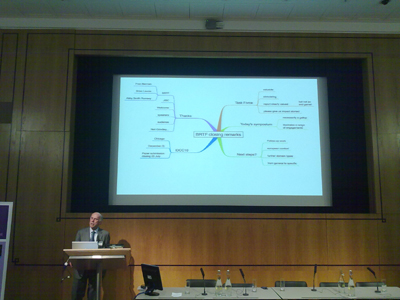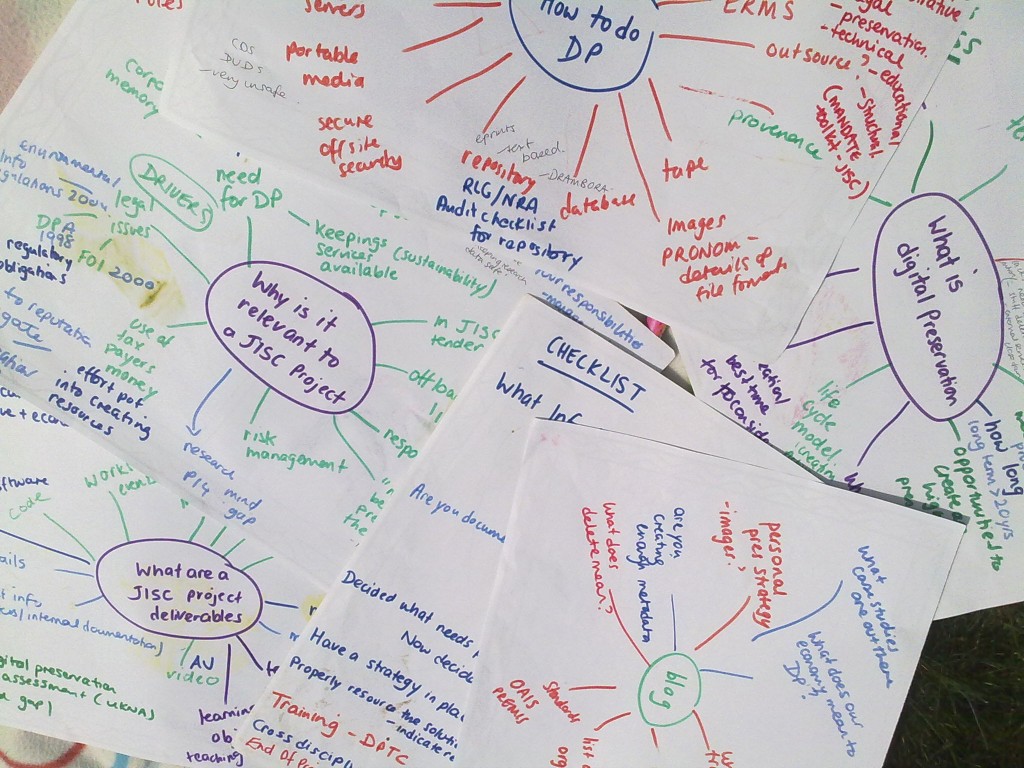Last week on election day (May 6th 2010) I attended the Blue Ribbon Task Force Symposium on Sustainable Digital Preservation and Access.
The symposium provided an opportunity for stakeholders to respond to the recent Blue Ribbon Task Force report entitled Sustainable economics for a digital planet: Ensuring long term access to digital information. The report is available to download in PDF Format.

Panel Session: Clifford Lynch, Adam Farquhar, Matthew Woollard, Graham Higley, John Zubrzycki
Introduction to the Report
Neil Grindley, JISC Digital Preservation Programme Manager opened the symposium by introducing the two UK members of the Blue Ribbon taskforce: Paul Ayris, Director of Library Services, University College London and the recently retired Chris Rusbridge, an Independent consultant.
After Paul Ayris’ introduction explaining that the taskforce had been set up to answer three key questions 1) What shall we preserve 2) Who will preserve it and 3) who will pay for it? Chris Rusbridge followed with a summary of Blue Ribbon activity and recommendations. He explained that despite what some might think sustainability of resources is not just about finding money, it is about incentivising. Yet current access to digital information is not a clear case; those who pay for it, those who provide it, and those whose benefit from it are not necessarily the same. With this in mind the Blue Ribbon Task force report has been written with an economic framework on board. Rusbridge also explained within the report they had set down that the case for preservation is the case for use. People don’t want digital preservation, they want access to resources: digital preservation is effectively a derived demand. The report conclusions offered an agenda for further action including looking at economies of scale and scope, chains of stewardship and investigation of public partnerships. It had laid down the foundations for a further report taking the next steps.
Brian Lavoie, Research Scientist at OCLC, and fellow taskforce member, then talked a little about the US launch; the products of the launch are available online. Lavoie explained that Clarity of licensing and devices like Creative Commons have been valuable in making resources preservable: they encourage third-party curation by enshrining the right to preserve.
A panel session on what the task force had actually achieved followed. The initial questions were posed by Paul Ayris and centred around the fact that while open access is now so high on everyone’s agenda, digital preservation remains low, almost invisible. It is very much a case of open access being today’s problem and digital preservation being tomorrow’s.
Different Perspectives
After a much needed coffee break the symposium moved onto session two chaired by Clifford Lynch of the Coalition for Networked Information, considering different sector perspectives. The view from the heritage sector was offered by Graham Higley Head of Library and Information Services at the Natural History Museum. Higley introduced the Biodiversity Heritage Library (BHL) at the Natural History Museum which holds about 1 million books. Many of the resources are very old with more than half of all named species documented in literature pre 1900. Preservation is considered a core part of BHL work and their long term access approach is LOCKSS based on international partnership guarantees and entirely on open source software.
John Zubrzycki Principal Technologist and Archives Research Section Leader at BBC Research followed with a view from public broadcasting. The BBC have 650k hours of video, 350k hours of audio, 2 million stills, 3 million items of sheet music, 400k “pronunciations”, 1.5 million titles in “grams library” and 100 km of shelves – that’s a lot of stuff and it will up to take 16 years to digitise all the 65 PetaBytes of existing content. The BBC Charter states obligations on the BBC to preserve output and the BBC is aiming to provide public web access to all its archived content by 2020.
Lunch was really good and gave us a chance to network and put faces to Twitter IDs. We then all proceeded back to the lecture theatre. The Data Manager’s perspective was given by Matthew Woollard, Director-Designate of the UK Data Archive. The UK Data Archive is a department at the University of Essex and provides infrastructure and shared services for various data archives. Wollard argued that it is a fallacy that researchers want to keep everything and that priorities for selection, curation and retention were key. In reality it costs the UKDA more to restrict access than to open it. Wollard is currently involved in formulation of the ESRC research data policy which will hopefully influenced by Blue Ribbon Task Force report. He ended with the suggestion that Data archives should use the arguments in the Blue Ribbon Task Force report report to leverage, not necessarily more money, but more sustainable money.
The final perspective was that of the national library. Adam Farquhar, Head of Digital Library Technology at the British Library where: “preservation is their day job”. They have to ask for permission to archive Web sites; of the 13,000 people asked only100 have said ‘no’, but then only 4,000 have responded. It is this Copyright investigation that costs time and money, establishing the right legislative foundation is a priority Farquahar talked about their use of Datacite and Dryad to support researchers by providing methods for them to locate, identify and cite research datasets with confidence. The British Library also has an interest in Planets and the Open Planets Foundation.
There followed a discussion on free-riders (those who use content but do not contribute to its upkeep), who exactly they are and whether they are a problem. Brian Lavoie explained that taxes pay for public bodies to perform preservation and therefore free use of these services is not ‘free’. The report itself is fairly critical of free riders, though those of use working in academia might believe that any use of resources should be encouraged. Matthew Wollard pointed out that the costs of excluding ‘free riders’ can be greater than costs of letting them in.
Higher Level Views
The final talks gave two higher level views: that of the European Commission and the JISC. Pat Manson, Acting Director of Digital Content and Cognitive Systems at the European Commission, talked about policy initiatives at European level and how they are tackling the sustainability challenge.
The JISC vision for digital preservation was provided by Sarah Porter, Head of Innovation at the JISC. The JISC are keen to ensure that organisations are prepared to undertake preservation and to embed preservation practice. Currently the JISC has taken no formal position in this area but one possibility is that they, as funders, create an explicit mandate for projects to follow. They are also considering if funders in different countries could work together on further actions and if they should create financial incentives for private entities to preserve in the public interest?

Chris Rusbridge sums up
The chair for the session Brian Lavoie then facilitated a discussion on ‘where do we go from here?’ One suggestions made was engaging beyond academia and the cultural sector at a high political and governmental level, promotion of this as one of the ‘big society’ challenges, how apt on the day of the election. Chris Rusbridge closed with the thought that the report offered something for us to build on but the scale of challenge required us to move on quickly.
After the symposium there was a drinks reception for those who didn’t need to rush back to cast their vote. I had an interesting chat with the BBC team, most of our talk focussed around where a possible new government would leave not just digital preservation but the public sector as a whole.
A longer version of this trip report will appear in Ariadne Web magazine.
More photos are available from the UKOLN Flickr site.


